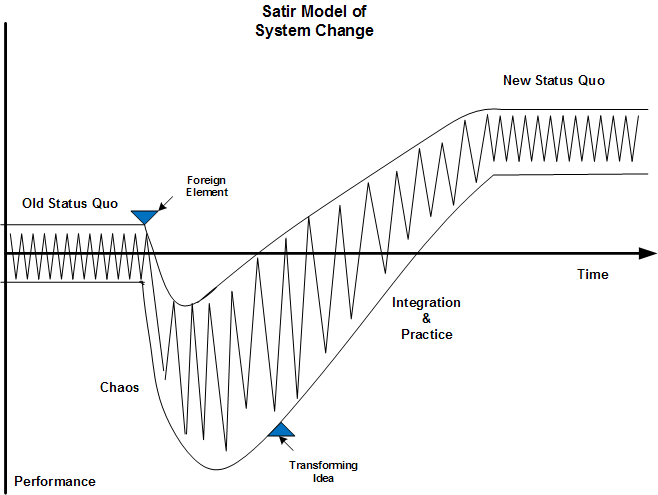All models are wrong. Some models are useful.
George E.P. Box
Although we’re constantly engaged in attempts to improve systems and organizations by introducing new practices and technologies, we still tend to do a mediocre job of dealing with the ensuing organizational changes. Part of our problem is that we tend to rely on very simplistic models of organizational change, when we think about it at all. I’ve recently been revisiting the issue in the literature and in my work. The organizing framework that I’m finding most robust and useful comes originally out of the work of Virginia Satir, a family therapist who adopted a dynamic systems perspective of interaction that translates nicely into organizational settings. I came to Satir’s work by way of Gerry Weinberg, a long time student of technology and systems induced change.
The following diagram captures the essence of Satir’s model of systems change:

In this model, the change process starts with the introduction of some “foreign element,” which might be a new system or a new manager or a new performance mandate from on high, disrupting the “Old Status Quo.” “Chaos” ensues and performance both falls and becomes more erratic until a “transforming idea” develops or is introduced. This transforming idea constitutes a new theory about how to operate in the new system. With a good transforming idea in place, there is a period of integration and practice as the organization learns how to perform in its new configuration. Eventually, we reach a “New Status Quo” operating at a new, hopefully higher, level of performance.
There are a number of features of this model that I find valuable. First, it acknowledges that performance is always variable, even during periods of relative stability. It’s an important reminder that the systems we are talking about are made up of people and we must allow for their humanity. Second, it makes it clear that change is fundamentally a learning process not a deployment process. Moreover, it is “learning how” not “learning that,” which should help us keep in mind that things will get worse as an inevitable and necessary part of getting better and that the learning will take time.
Finally, there is the notion of a “transforming idea.” All too often, by the time we get to deployment, we’ve forgotten why we embarked on the journey to begin with. Articulating and sharing an effective transforming idea is an essential step in achieving the new levels of performance we are seeking. Human systems are homeostatic; they seek out and maintain stability. Absent a compelling transforming idea, these homeostatic forces will drag the system back to its current status quo. With a good “big picture” in mind, the participants in the changing system have a goal that can guide them through the necessary integration and practice.




